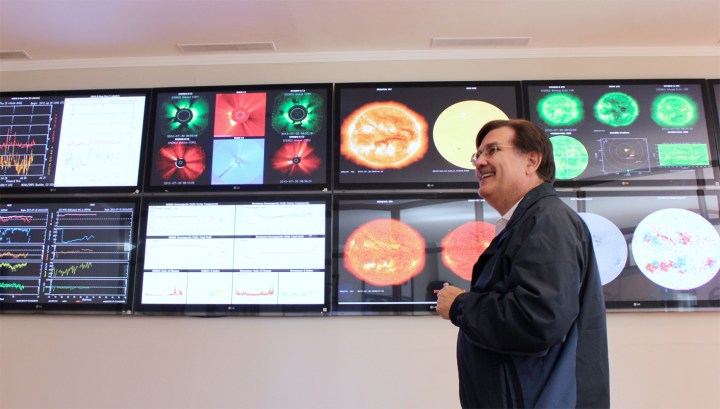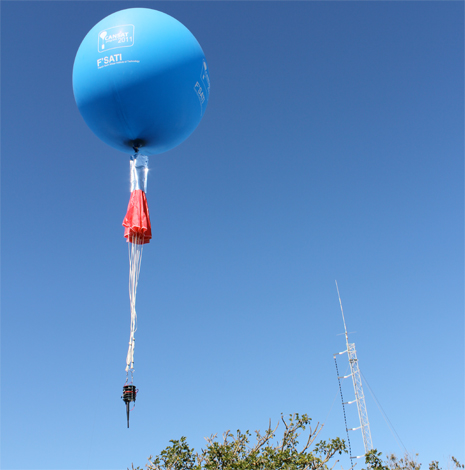Maverick Life
Sun-spotting SA

The department of science and technology has declared 30 July - 6 August to be National Science Week, under the theme of “The Role of Science and Technology in Economic Development”. To mark the occasion, REBECCA DAVIS visited the South African National Space Agency to find out how useful our sun-gazing scientists really are.
Kobus Olckers sits and looks at the sun all day. Not with his bare eyes, obviously. “I’d have to be Superman,” he says. His sun scrutiny takes place in front of a bank of screens, each with a different image. On one, a spinning red orb flickers and flashes. Another screen shows a static yellow sphere with a few black dots. Others are reserved for colourful graphs. If the sun were suddenly to explode with a solar flare, Olckers would be one of the first people on Earth to know about it, because he’d be sitting right here, watching his screens, in a small room in Hermanus.
Hermanus, the seaside town 127km outside Cape Town, best known for its annual whale migration, might seem like an unlikely place for the location of Sansa’s space science unit. Actually, it’s the perfect place, literally, and to explain why we have to go back to 1933. In that year, a magnetic observatory was built on the grounds of the University of Cape Town. An international commission found it essential to construct this facility “because of its situation in the southern latitude, from which, considering the network of existing stations, magnetic observations are particularly required”.
There was one problem, however: the electrification of the railway lines, which created too much interference to be able to make accurate observations in the heart of Cape Town. They needed a site that was far removed from any railway networks, and Hermanus was found to be ideal. On 1 January 1941 construction began on the Hermanus Magnetic Observatory. Today that same site houses Sansa’s space science facility, with the area expanded to encompass 16 hectares of protea-filled land to buffer the facility from interference from the suburban sprawl close by.
Sansa is a relatively recent development, arising from the National Space Agency Act, which was signed by Kgalema Motlanthe in 2009 in order to bring together all South African space-related activities under one banner. You may be surprised to learn just how many of these activities there are – and we’re not even talking about the Square Kilometre Array telescope project, which is entirely separate.
Within Sansa we find the earth observation unit, located at Hartebeeshoek, near Johannesburg, which is responsible for aspects like images of Earth downloaded from satellites. Then there’s space operations, also at Hartebeeshoek, which takes care of satellite tracking, as well as ground station support (including mission control) and space navigation. Rounding it off, we have what will eventually be space engineering – to build the technology – and space science, sitting in a collection of modest whitewashed buildings on its Hermanus site.
The reason why Olckers has to watch the sun all day is because he works as Sansa’s space weather officer. The facility operates the only space weather centre in Africa. When it comes to what they actually do, Olckers says, with a hint of pride: “We are practical. We predict things. We get data from any source and turn it into information that we can use to warn people.”
What they are warning people about are the effects of space weather. Space weather is different from terrestrial weather. The sun is the godfather of space weather: it calls all the shots. The sun makes weather by, for instance, continually emitting particles that flow through the solar system at about 7,000km per hour. This effect is known as the solar wind. We also hear quite a lot these days about solar flares, which are releases of energy that on occasion herald the imminent arrival of a Coronal Mass Ejection (CME) – essentially a large cloud of very hot gas blasted out from the sun.
Olckers’ bank of screens provides him with a wealth of information, ranging from the speed of solar winds to the direction of solar flares, and whether these are heading towards Earth. “You can see there’s a fairly active area coming, probably 11 or 12 days from now,” he says, gesturing towards a screen which measures activity in the corona (the ring around the sun). “So we can do fairly long-term predictions.”
It’s important to know about upcoming space weather conditions because they can play havoc with our technology. Satellites, cellphones, navigation systems on airplanes, GPSs in our cars, and internet connections can all experience interference from phenomena like CMEs and solar winds. When Olckers and his team figure out the likely forecast for the near future, they broadcast it on their website and from their Twitter account.
Reading through their past tweets, you can see that the sun has been in a placid mood recently: “No solar events in progress”, reads the report for 19 July, and “Space weather is very quiet at the moment” is the outlook for 26 July. On certain days, the forecast sounds distinctly more ominous (though somewhat obliquely so). On 4 April, for instance, we read that: “Interplanetary magnetic field conditions are at unsettled levels due to a glancing blow of the CME that erupted on April 2”. When trouble is spotted, they can judge its duration in an astonishingly precise way: “M-Class X-Ray flare in progress,” the centre tweeted on 6 March. “Cellphone and internet disruptions are being experienced. Estimated duration: another 45 minutes”.
The sun’s fickle moods may mess with our internet in an irritating way, but a healthy respect for the boiling gas ball is called for. It is 4,57 billion years old, for a start – Olckers estimates that the old girl has another 5 billion years of life in her – and so big that more than a million Earths could fit inside her. Without the sun, we wouldn’t have enough heat to sustain life, and we also would lose our orbit and hurtle off into space. And, as inconvenient as losing signal on our GPS may be, the space weather created by the sun poses no direct harm to us.
“The one thing that people must realise is there’s absolutely no danger to human beings, unless you’re up there in a space station. Even then, the ISS (International Space Station) has a water tank to absorb radiation that they all have to get into and stay there. It’s only about the size of a toilet, but fortunately (adverse conditions) don’t last long. Although two weeks ago we had one that lasted about a day,” Olckers says.
That isn’t to say that space weather can’t have dramatic effects. In 1989 an unexpected solar flare took out electricity in Canada’s Quebec and Ontario provinces – and New York state in the US – for a full three days. South Africans used to Eskom’s vagaries would no doubt laugh this off, but the thought of what would happen if this were to occur in a more widespread fashion is certainly food for thought.

Photo: A SANSA ‘Cansat’ nano-satellite takes to flight at their facility in Hermanus (Jeanine Cameron)
Sansa space science MD Lee-Anne McKinnell notes that the centre is only part of the facility’s work. “This particular facility has some very unique things we do for the nation,” she says. “The other way we contribute directly to the nation is through our electro-magnetic technology.” This technology takes place in the facility’s techno lab, a building fitted out with an aluminium roof to ensure no interference. Inside it, work is being done with magnets and compasses which will eventually be of use to the defence and aviation industries, helping to guide aircraft and missiles. A sticker on a whiteboard records a nerd’s joke: “My Other Vehicle Is Unmanned”.
“We’re the only facility in the country that can do compass calibration,” McKinell says. “We wouldn’t be able to do that if we didn’t have experts in magnetism, and if we didn’t have a uniquely magnetically free facility.” She points out that some of their magnet-related research may have unexpected and far-ranging applications. “There’s a very interesting project we’re doing looking at magnetic shielding for sharks,” she says. “We’re working with the sharks conservancy board to see whether a magnetic field could be a protective barrier between humans and sharks.”
Then there’s the educational aspect to Sansa: their “space lab”, hosted in a Samsung mobile van, is about to head off to De Aar in the Northern Cape to bring some of the excitement of space science to school children there. One of their favoured tools to teach kids about what they do is their “Cansat” launches, which sees them launch a very simple satellite – built using a primitive computer, a cellphone battery and a Coke can – into the air with a helium balloon attached to a length of twine. Up there, the “nano-satellite” will measure temperature, altitude and atmospheric pressure before dropping to earth with the aid of a little parachute. They say it’s a fun and effective way to teach children both about the mechanism and purpose of satellites.
McKinell sees this aspect as making a particularly important contribution. “We’re using space science as a driver to generate excitement in science, and through that, to focus on the need for innovation. A lot of the technology we currently use every day – in our cellphones, for instance – started off as innovative solutions in a space programme,” she points out. “So there’s a lot of indirect benefits.”
As I leave the Sansa space science facility, Olckers is watching the sun as patiently as ever. “Quiet for the moment,” his tweet for the day reads, “but the coronal hole should become geo-effective later today”. Everybody, keep calm. DM
Read more:
- Sansa Space Science website
Main photo: SANSA Space Weather Office Kobus Olckers with the screens he uses to monitor solar activity

















 Become an Insider
Become an Insider